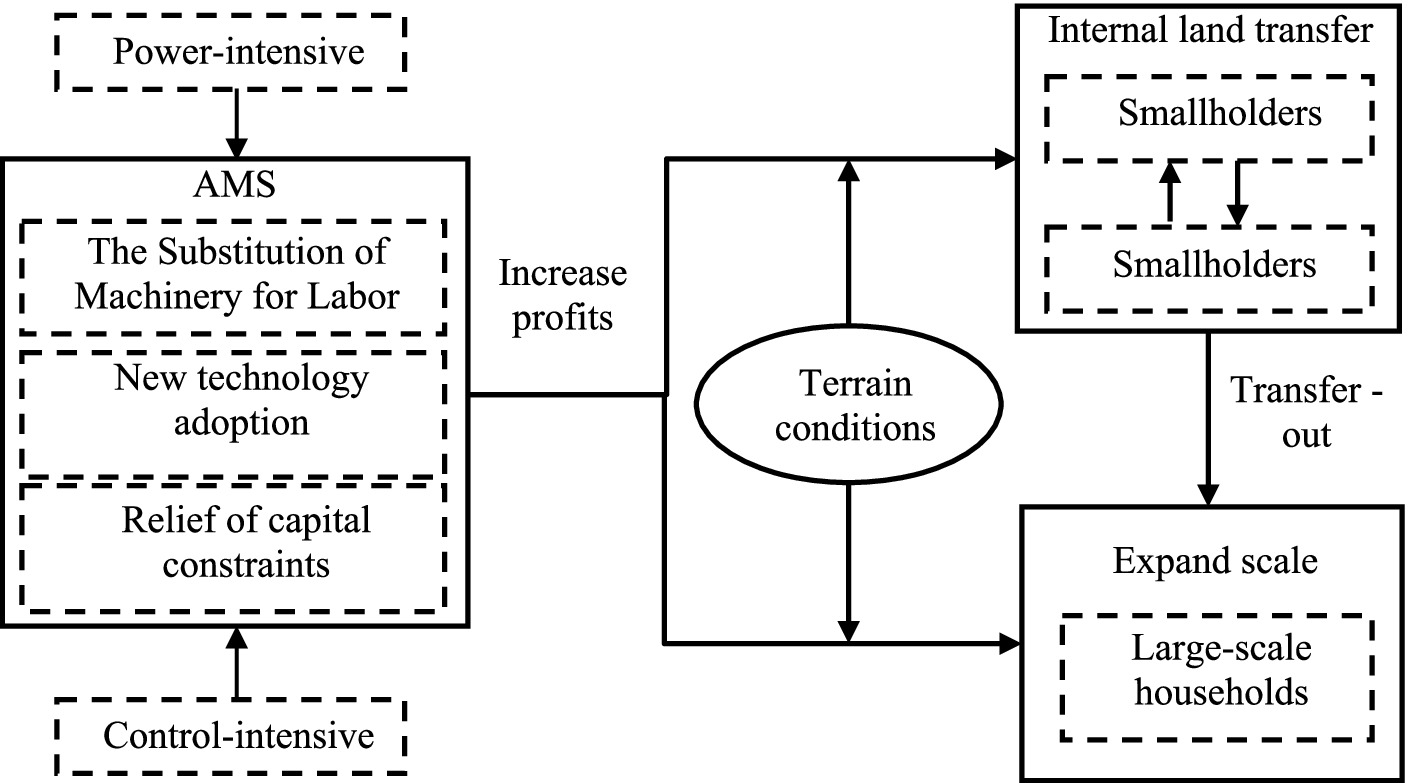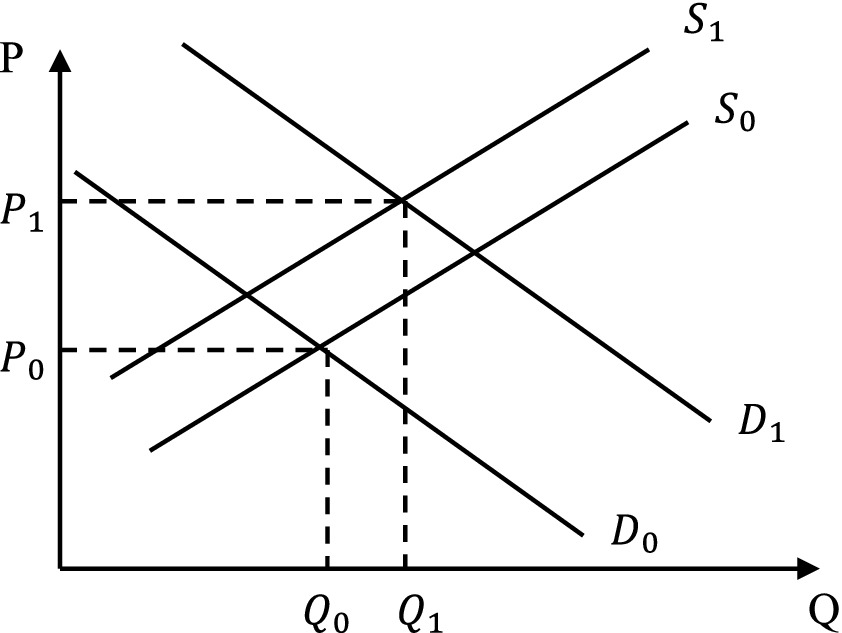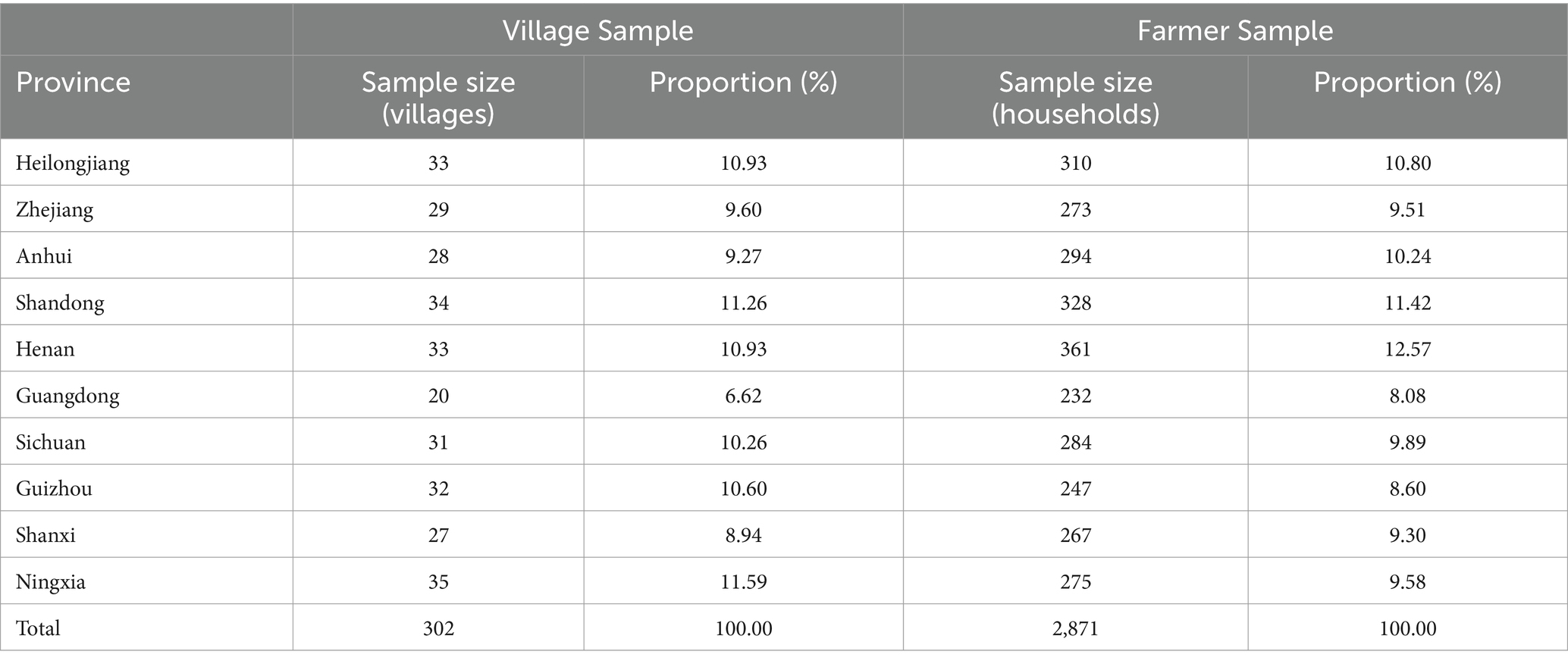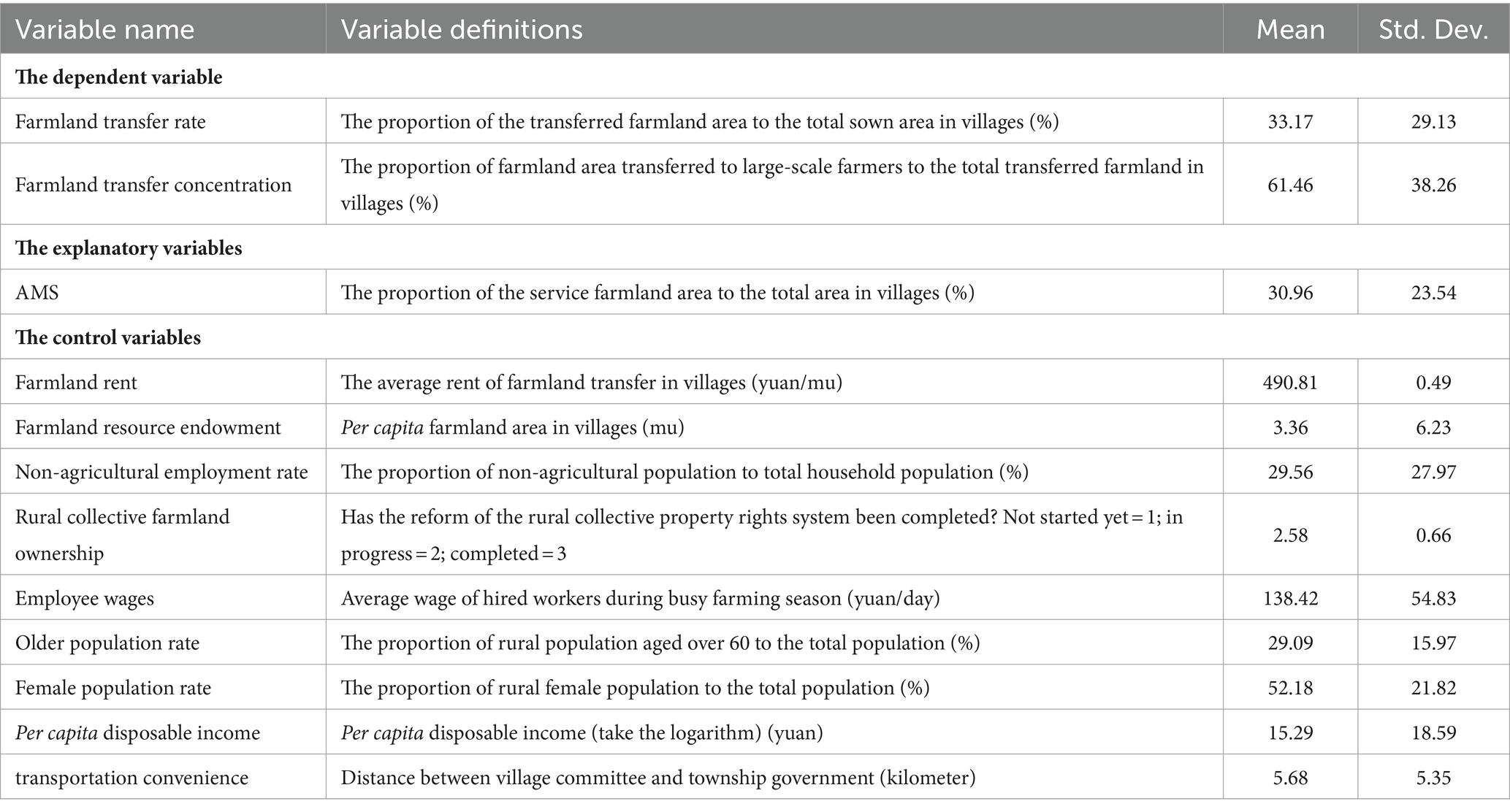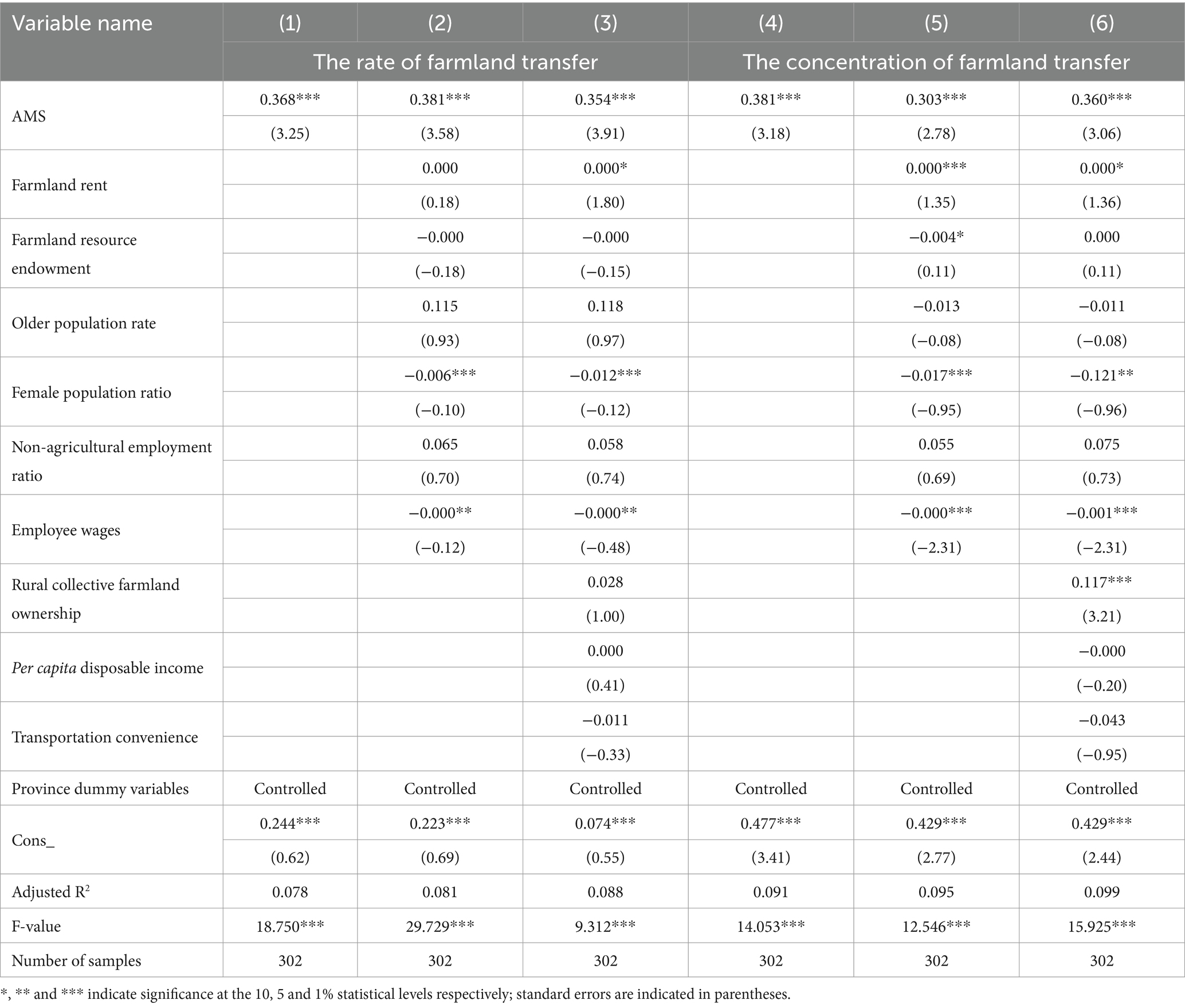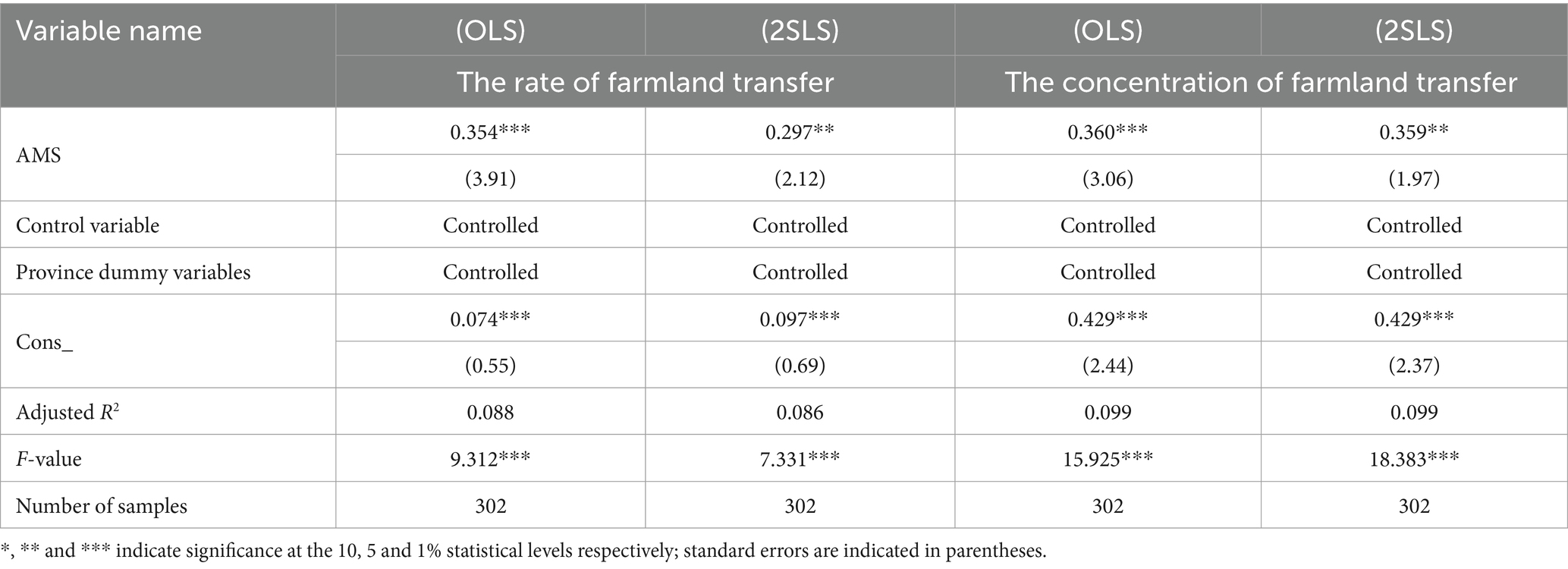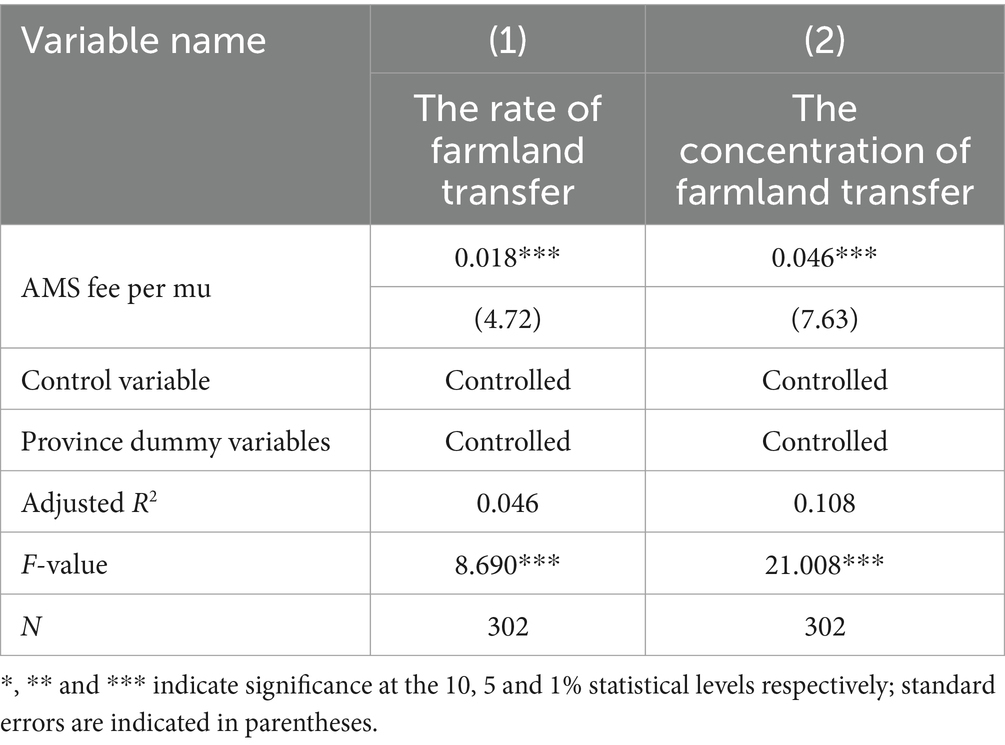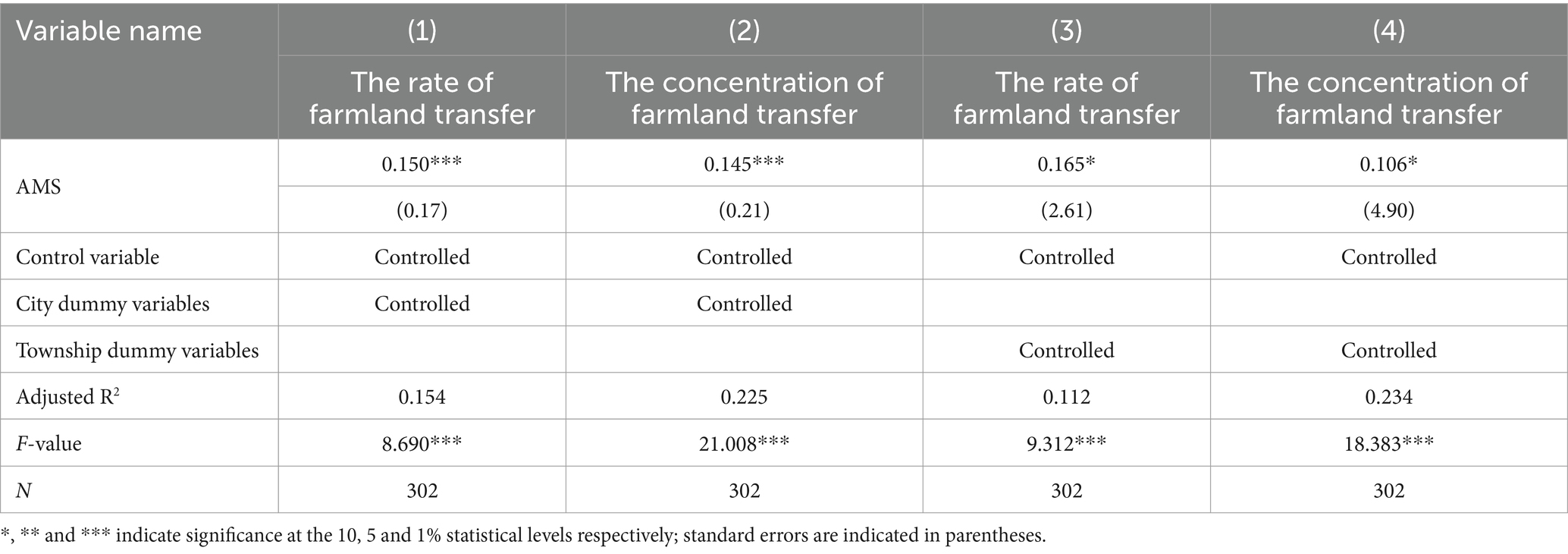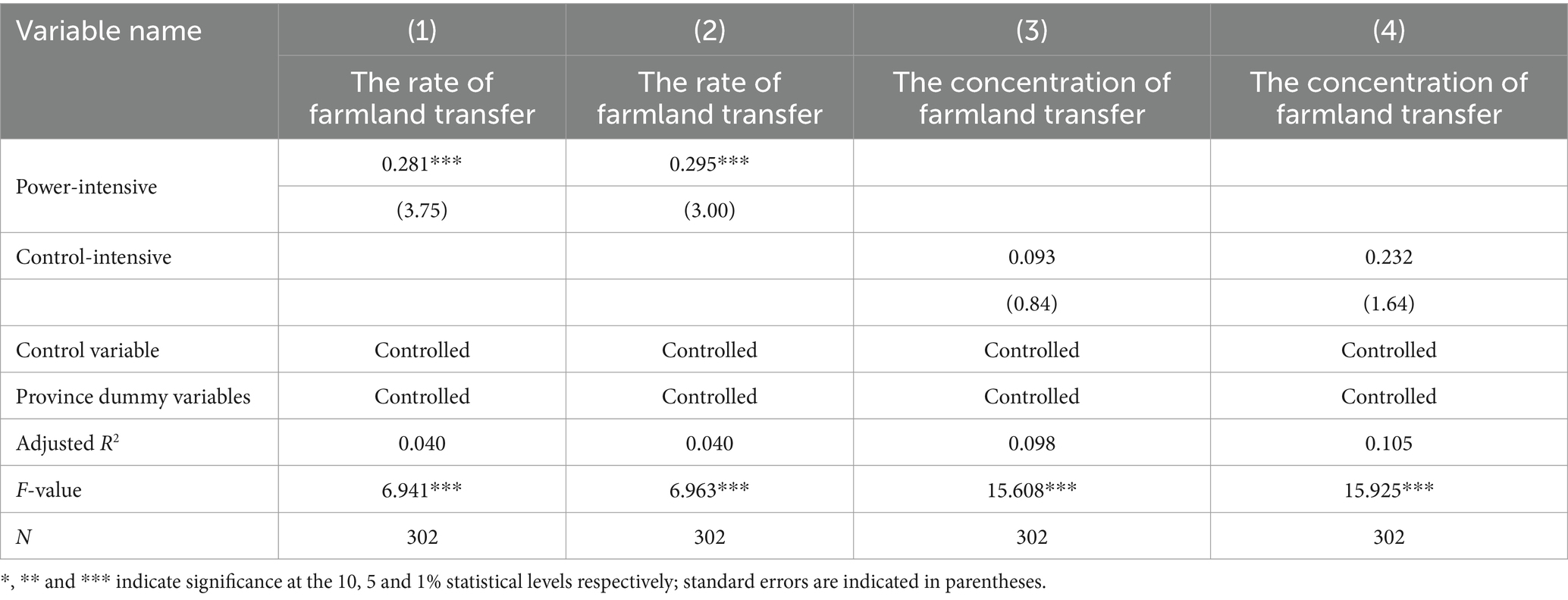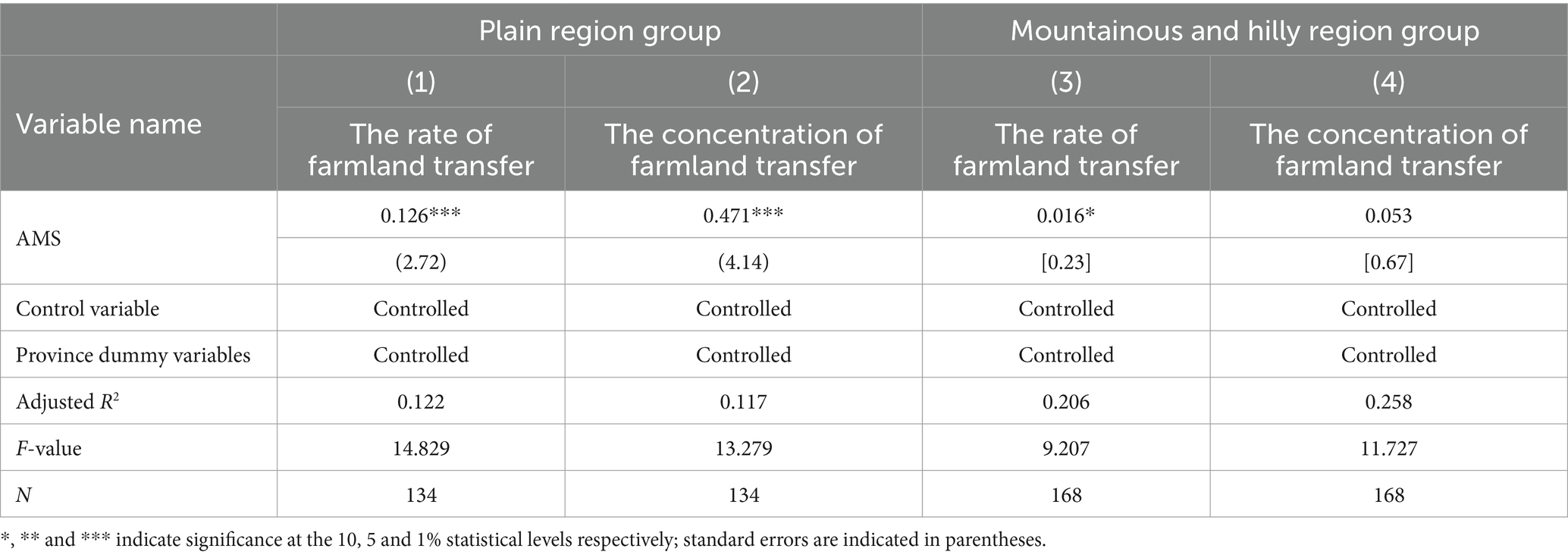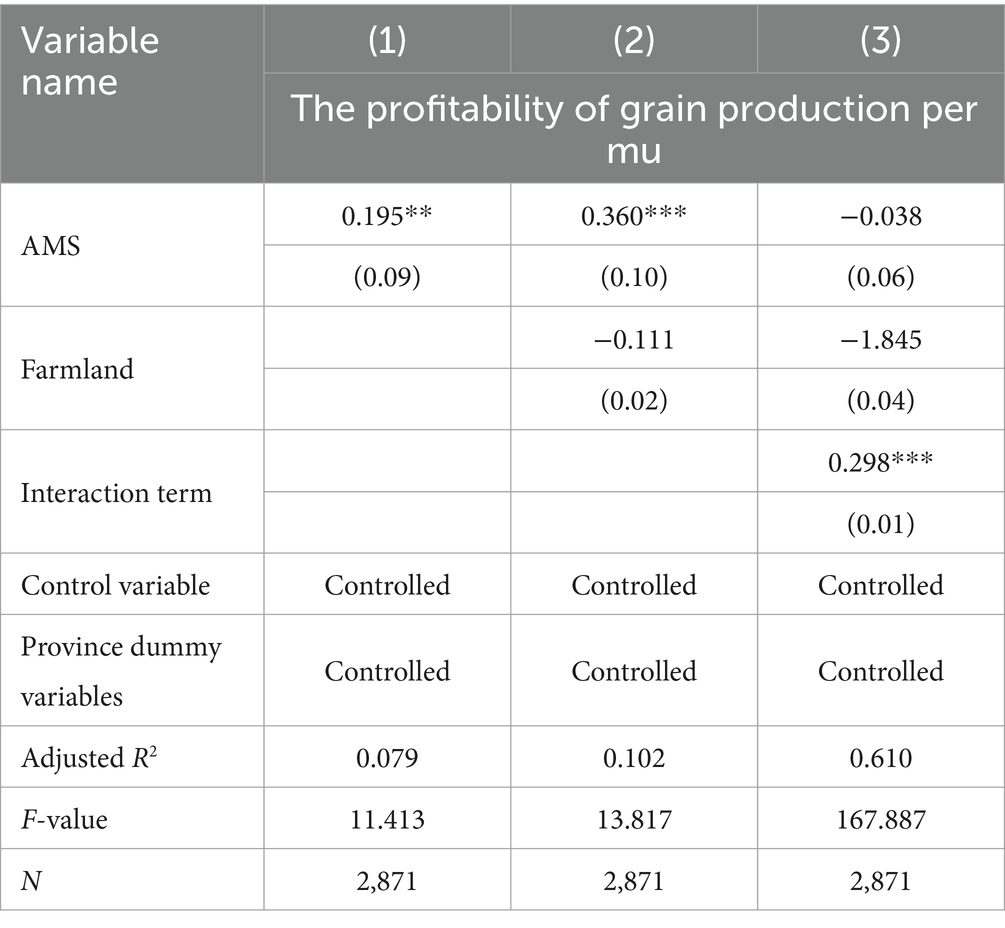- College of Economics and Management, Nanjing Agricultural University, Nanjing, China
Introduction: In the context of the deceleration of farmland scale management, a crucial question arises in agricultural development theory and practice: will service driven scale management in the production process become a viable alternative to farmland scale management, serving as the secondary pathway to achieve scale management in China?
Methods: To address this issue, an empirical analysis on the impact of agricultural machinery services on farmland transfer was conducted in this article using data from the China Rural Revitalization Survey database comprising 302 villages and 2,871 micro-farmers in 2020 by utilizing the ordinary least squares method and instrumental variable method.
Results and discussion: The results show that the implementation of agricultural machinery services will increase the rate of farmland transfer in villages. The effect of agricultural machinery services on increasing the profitability of large-scale farmers surpasses its effect on smallholder farmers, thereby motivating smallholder farmers to transfer farmland to large-scale farmers, consequently fostering the consolidation of farmland. In addition, power-intensive service links are more effective in increasing the rate of farmland transfer and fostering the concentration of farmland transfer compared to control-intensive service links. The impact of agricultural machinery services on enhancing the rate of farmland transfer and fostering the consolidation of farmland transfer is more pronounced on the plain areas compared to the hillmountainous areas. Consequently, this article demonstrates that service-driven scale management and farmland scale management are not merely alternatives but rather complementary strategies that mutually reinforce each other.
1 Introduction
In recent years, China’s domestic grain supply and demand market has been characterized by the “three highs” phenomenon comprising high output, high inventory, and high imports. This trend further highlights the lack of international competitiveness in China’s grain production, primarily attributed to the relatively small average farmland scale (Huang, 2000; Chen et al., 2022). Transitioning from fragmented smallholder farming to large-scale management is imperative for improving labor productivity and enhancing the international competitiveness of grain production in China (Foster and Rosenzweig, 2011; Xu, 2023). Despite the positive outcomes observed in the recent decades with the development of large-scale management through farmland transfers, this approach has not significantly changed China’s grain production pattern. The data show that China’s average farmland scale in-creased from 5.36 acres in 2006 to 7.09 acres in 2020. Despite this increase, by the end of 2020, 85.1% of farmers in China still had less than 10 acres of farmland, with 95.8% of farmers owning less than 30 acres of farmland (Statistical Annual Report on Rural Management in China, 2019–2020). Consequently, China’s farmland transfer rate began to decline annually after peaking at 38.90% in 2018. These trends indicate that both currently and for the foreseeable future, China’s grain production will primarily rely on smallholder farmers.
Under the current national and agricultural circumstances, scale management can be achieved by advocating for the establishment of an agricultural socialized service system, integrating traditional family management into a social network of agricultural activities, fostering connections between smallholder farmers and modern agricultural practices, and promoting service-driven scale management (Thapa et al., 1998; Gillespie et al., 2010). Agricultural mechanization services (AMS) are crucial part of agricultural socialized services, and the field has gained substantial attention in ongoing discussions (Qian et al., 2022). By the end of 2020, China had 270 million farmers, with only 39.94 million farmers engaged in agricultural machinery investment, accounting for 16.64% of the total farmer population (China Agricultural Machinery Yearbook, 2020). Nevertheless, China has achieved a comprehensive agricultural mechanization rate of 71.25%, primarily driven by the widespread adoption of efficient large-sized and medium-sized agricultural machinery, largely attributed to the rapid growth of the AMS market (Otsuka et al., 2013; Zhang et al., 2017; Yan et al., 2019).
In the context of the aging and increasing feminization of the rural labor force, the rapid development of AMS has provided farmers access to cost-effective mechanization services, effectively fulfilling their need for agricultural machinery in grain production. Smallholder farmers operate on a smaller farmland scale and encounter higher purchase costs from agricultural machinery, so AMS should be more appealing to them, increasing their operational profitability while preventing farmland transfer (Yang et al., 2013). However, the reality was that a larger proportion of large-scale farmers adopted AMS compared to smallholder farmers.1 The average adoption proportion of AMS among smallholder farmers increased from 65.63% in 2009 to 71.64% in 2017, whereas the adoption proportion among large-scale farmers increased from 74.42 to 81.36% (National Rural Fixed Observation Points, 2009–2017). Moreover, although smallholder farmers still constitute the majority of agricultural production in China, the number of large-scale farmers has been steadily increasing yearly. The number of farmers owning more than 50 acres of farmland increased from 2.74 million in 2009 to 4.52 million by the end of 2020. The development of AMS did not seem to have slowed the concentration of farmland or the advancement of farmland-scale management (Yang et al., 2013). Therefore, in the context of the government’s initiatives to promote farmland scale management, does the development of AMS exacerbate farmland dispersion or promote farmland concentration? In addition, will it impede China’s progression toward farmland scale management?
Several studies have explored the effectiveness of service-driven scale management versus farmland scale management to address the issues mentioned above. China’s resource distribution, characterized by a high number of people and limited farmland, indicates the necessity of development of farmland scale management through farmland transfer (Fei et al., 2021; Zhang et al., 2022). This represents the farmland transfer from small farmers to large-scale farmers is main means of achieving farmland consolidation (Yan et al., 2016; Li, 2023). Studies typically indicate that farmers’ decisions to transfer farmland are influenced by economic factors and mutual favors exchanged among farmers (Wang et al., 2011; Liu, 2018). Some farmers forfeit farmland rent for other demands, leading to a significant proportion of farmland transfer among small-scale farmers, hindering the consolidation of farmland and the advancement of farmland scale management (Gao et al., 2012; Chen et al., 2017). However, when the farmland rental price is higher, farmers may prioritize farmland rent over other demands. The farmland rent increases only when the recipients of farmland transfer-in get higher profitability of grain production compared to the recipients of farmland transfer-out, suggesting that farmers’ farmland transfer decision influenced by profitability of grain production essentially (Wang et al., 2018).
Existing research has acknowledged the impact of AMS on farmers’ grain production profitability and farmland transfer behavior. Specifically, AMS have effectively increased the profitability of grain production by alleviating constraints on production factors such as capital, lobar and technology (Guan and Alfons, 2006; Qiu et al., 2018; Zhang et al., 2011; Zhang et al., 2017), consequently increasing the rent for farmland transfer (Kang et al., 2020; Qing et al., 2019). In addition, most of these studies have argued that the development of AMS saves farmers’ family labor while avoiding the purchase of agricultural machinery by farmers themselves, thus contributing to increasing farmers’ profitability of grain production, which inhibits smallholder farmers from transferring their farmland to a certain extent (Huang and Ding, 2016; Sheng et al., 2017; Qiu et al., 2021; Chen et al., 2022).
Although previous research acknowledges the impact of AMS on farmers’ operating profit, it primarily focuses on small-scale farmers and does not comprehensively address the differences in AMS adoption by farmers at various farmland scales and does not delve into the interrelationships between the two types of scale management trajectories. These studies also fall short in fully elucidating the varying adoption rates of AMS among farmers and the intrinsic relationship between service-driven scale management and farmland scale management. When large-scale famers reap more benefits from AMS than smallholder farmers, they are more likely to adopt AMS instead of investing in agricultural machinery and paying higher farmland rent to acquire farmland from smallholder farmers (Houssou et al., 2013). Focusing solely on alleviating production constraints for smallholder farmers hinders a comprehensive understanding of the relationship between service-driven scale management and farmland scale management. Consequently, it is imperative to simultaneously evaluate AMS’s impact on large-scale farmers. This article proposes that AMS has varying impacts on alleviating constraints for small-scale and large-scale farmers. These effects change the profitability of grain production and disrupt the balance of supply and demand for farmland in the transfer market, subsequently influencing the expansion of farmland scale management.
In this article, village-level and farmer-level data from the “China Rural Revitalization Survey” (CRRS) database, initiated by the Institute of Rural Development of the Chinese Academy of Social Sciences, were used to systematically explore the impact of AMS on farmland transfer rates and the consolidation of farmland transfer in villages. The primary contributions of this article can be grouped into two categories: on an academic level, it builds upon previous research by conducting a more in-depth analysis of the impact of AMS on the direction of farmland transfer. In addition, it highlights the varied effects of AMS on farmers’ profitability of grain production, which is a crucial determinant of farmland transfer behavior, thereby enhancing the research perspective on scale management. On a practical level, this article elucidates the intrinsic relationship between farmland scale management and service-driven scale management, offering valuable insights to facilitate the progress of scale management initiatives.
This article is structured as follows. Section 2 shows the theoretical relationship between AMS and farmland transfer and propose research hypotheses. Section 3 introduces the data sources and the construction of econometric models. Section 4 presents the empirical exercise, generating new evidence on the relationship between AMS and farmland transfer from the village-level and farmer-level data. Section 5 discusses the contribution of the article. Section 6 draws conclusions and lay out the policy implications.
2 Theoretical analysis and research hypotheses
This article contends that the impact of AMS on the profitability of grain production varies depending on farmland scale, disrupting the original balance between the supply side and the demand side in the farmland transfer market, and establishes an analytical framework as depicted in Figure 1.
2.1 The impact and mechanism of AMS on farmland transfer
2.1.1 The impact of AMS on the profitability of grain production
The neoclassical economic theory postulates that productivity is enhanced through division of labor and specialization. AMS involve traditional family management within social networks, enhancing the degree of division of labor in grain production. This effectively addresses the constraints faced by farmers regarding production factors while improving agricultural productivity. Specifically, AMS substitute manual labor with machinery, mitigating the challenge of insufficient labor in grain production (Xu, 2023). Moreover, AMS enable farmers to forego individual purchases of agricultural machinery, easing the capital constraints faced by farmers. Organizations providing AMS have more enhanced skills, reducing input requirements of production factors such as seeds, fertilizers, and pesticides. Furthermore, AMS help alleviate the technical constraints encountered by farmers (Wei and Lu, 2023).
The inherent characteristics of agriculture indicate that the benefits of intra-family division of labor are not apparent (Poulton et al., 2010; Li, 2011). When farmers operate on relatively small farmland scale, their family labor can adequately manage the daily requirements of grain production, leading to relatively limited demand for AMS. However, as farmland scale expand, agricultural production faces significant constraints on production factors, intensifying the demand for labor, technology, and capital. This implies that large-scale farmers rely more heavily on the service market compared to smallholder farmers (Wang et al., 2011; Hong et al., 2017). Large-scale farmers, benefiting from concentrated and contiguous farmland and specialized regional cultivation, reduce the transfer costs associated with agricultural machinery across different plots. This approach maximizes the operational efficiency of agricultural machinery and enhances bargaining power, facilitating the realization of economies of scale from AMS. Theoretically, the higher number of AMS links adopted by farmers, the more significant the impact on mitigating factor constraints and reducing production costs they can achieve (Hicks and Taussig, 1932; Hayami and Ruttan, 1985; Hansson, 2008). This indicates that, large-scale farmers reap significant benefits from AMS considering the perspective of substituting labor with machinery or saving costs on purchasing machinery.
2.1.2 The impact of AMS on farmland transfer rate and consolidation
China’s farmland scale management relies on the farmland transfer. Smallholder farmers are the main recipients of farmland transfer-out parties, whereas smallholder farmers and large-scale farmers are both recipients of farmland transfer-in owing to the resource characteristics of more people and less farmland (Liu et al., 2019; Rogers et al., 2021). The impact of AMS on increasing profitability of grain production will deter smallholder farmers from transferring farmland, resulting in a shift of the farmland supply curve from to on the supply side of farmland (Figure 2). The impact of AMS on enhancing the profitability of grain production of large-scale farmers will encourage them to transfer farmland and scale up their farmland scale, leading to a shift of the demand curve from to on the farmland demand side. AMS has a more pronounced effect on increasing profitability of grain production for large-scale farmers, thus the farmland demand curve shifts to the right more than the supply curve shifts to the left. Consequently, this results in an increase in farmland transfer rent ( shifts to ) and increase in volume of farmland transactions ( shifts to ).
The resource endowment characteristic of a high population and limited farmland in China determines that farmland transfer among smallholder farmers has always been prevalent (Chen et al., 2017). Due to the impact of AMS on increasing the profitability of grain production for large-scale farmers surpasses its effect on smallholder farmers, smallholder farmers cannot achieve marginal returns comparable to those of large-scale farmers through AMS, so they are inclined to make a more rational decision to transfer farmland to large-scale farmlands to obtain higher rental income (Zhang et al., 2020a,b; Wang et al., 2023). Therefore, the development of AMS helps to increase the farmland transfer rate in villages, fostering the consolidation of farmland transfers to some extent.
On the basis of the above analysis, this article proposes the following two research hypotheses.
Hypothesis 1: The development of AMS will increase the farmland transfer rate in villages.
Hypothesis 2: The impact of AMS on increasing the profitability of grain production for large-scale farmers surpasses its effect on smallholder farmers, thereby motivating smallholder farmers to transfer farmland to large-scale farmers, consequently fostering the consolidation of farmland.
2.2 Heterogeneity in the impact of AMS on farmland transfer
2.2.1 The impact of AMS in different service links on farmland transfer
Although AMS generally contribute to an increase in the rate of farmland transfer and facilitate the consolidation of farmland transfer, their impact varies across different service links due to differences in production technologies. In practice, AMS can be categorized into power-intensive service links and control-intensive service links, based on the degree of power size demand and management skills required (Pingali, 2007). Power-intensive service links are characterized by high labor intensity and significant physical exertion, requiring substantial power and energy support. Additionally, these service links are highly standardized, making them more suitable for replacement by agricultural machinery instead of manual labor, such as cultivation, harvesting, irrigation, and vehicle transportation. Control-intensive service links require higher levels of specialized expertise and skills, mainly focusing on the management and operation of grain production, even when labor is replaced by machinery. It is relatively challenging to completely replace these links with machinery, such as seeding, fertilizing, and spraying.2
Larger-scale farmers require a higher degree of mechanization to replace labor from the perspective of extending crop growth time or minimizing marginal output losses resulting from farmland scale expansion (Otsuka et al., 2013; Adamopoulos and Restuccia, 2014; Zhang et al., 2017). Power-intensive service links, characterized by standardized operational procedures, are more readily able to substitute labor with machinery in agricultural production, promoting large-scale farmers to increase farmland scale and achieving the concentration of farmland transfers (Foster and Rosenzweig, 2022). Conversely, control-intensive service links require advanced expertise and operational skills, posing challenges to achieve complete labor substitution with machinery, especially in tasks such as fertilization and pesticide application. Additionally, due to the increased cost of services driven by labor participation, it has also limited the potential growth in profitability of grain production, weakening the role of AMS in promoting farmland transfer.
Based on the above analysis, the following hypothesis is proposed.
Hypothesis 3: Power-intensive service links have a greater influence on increasing the rate of farmland transfer and fostering the consolidation of farmland transfer compared to control-intensive service links.
2.2.2 The impact of AMS in different topography on farmland transfer
The impact of AMS on farmland transfer is constrained by the topographical features of farmland (Xu and Zheng, 2017). In flat terrain areas such as plains, the even topography of farmland facilitates the extensive substitution of labor with agricultural machinery and maximizes machinery’s operational efficiency (Riordan and Williamson, 1985; Gillespie et al., 2010; Daum et al., 2021). This enhances the impact of increasing farmers’ profitability through the adoption of AMS and augments the potential for effective farmland transfer. In hilly and mountainous areas, the rugged terrain and fragmented, dispersed farmland parcels pose challenges to the substitution of labor with agricultural machinery and reduce the efficiency of machinery operations. Consequently, AMS’s positive impact on farmland transfer is weakened. This demonstrates that the terrain characteristics of farmers’ farmland influence the impact of AMS on their profitability of grain production.
Therefore, the following hypothesis is proposed.
Hypothesis 4: The topographical features of farmland impede the operational efficiency of AMS. The impact of AMS on farmland transfer is more pronounced on the plain areas compared to the hill-mountainous areas.
3 Research design
3.1 Data sources
The data analyzed in this article are from the China Rural Revitalization Survey (CRRS), a database that comprises information from a comprehensive nationwide rural tracking survey conducted by the Institute of Rural Development, Chinese Academy of Social Sciences. The initial phase of this large-scale survey is conducted from August to September 2020 in 10 provinces, covering 50 counties (cities) and 156 townships (towns) across the country. It involved the collection of over 300 village questionnaires and more than 3,800 farmer household questionnaires, capturing data from over 15,000 family members. The dataset comprised three key components: individual data, farmer data, and village data. The individual-level data encompasses the of respondents’ basic characteristics, education status, and employment status. The farmer-level data comprised demographic characteristics, income and expenditure patterns, crop planting practices, farmland transfer records, and other relevant aspects. The village-level data included population demographics, organizational structures, farmland conditions, rural development initiatives, and agricultural production and operations.
This article uses five standard deviations from the average farmland scale as the threshold to remove samples, and also excludes samples with missing key information. After eliminating outliers and missing values, the dataset comprised 302 village samples and 2,871 farmer samples (Table 1). Village samples are primarily used to analyze the impact of AMS on farmland transfer, with the relationship between the two being influenced by the geographic characteristics of grain-producing areas. For instance, the Northeast region has flat terrain and higher continuity of farmland; the Southwest region features rugged terrain with fragmented farmland; and the Southeast region, while relatively flat, has a dense population leading to lower per capita farmland. Overall, the article sample is quite balanced, including 159 rural samples from major grain-producing areas (Heilongjiang, Anhui, Shandong, Henan, Sichuan) and 143 rural samples from non-major grain-producing areas (Zhejiang, Guangdong, Guizhou, Shaanxi, Ningxia).3 Farmer samples are primarily used for mechanism testing. Our article samples include farmers growing single-season wheat, corn, and rice in villages. Wheat, corn, and rice are the three main staple crops grown in China. Among the samples, 752 are wheat farmers, 1,414 are corn farmers, and 705 are rice farmers. In contrast to previous studies that predominantly utilize samples of smallholder farmers, this article’s farmer sample includes not only smallholder farmers but also a significant number of farmers’ farmland scale exceeding 30 mu, thus possessing better representativeness and comparability. In the dataset, the average farmland scale of the sample farmers is 19.53 mu, of which 345 farmers are classified as large-scale farmers, accounting for 12.02% of the total, and 2,526 farmers are categorized as smallholder farmers, representing 87.98% of the total.
3.2 Model construction
Since the dependent variable, the rate of farmland transfer and the concentration of farmland transfer, are continuous variables, this article will employ the Ordinary Least Squares (OLS) method, which is better suited for identifying the causal relationship between these variables. To illustrate the impact of AMS on farmland transfer in villages, we have established the following model based on data from 302 village samples:
In Equation 1, the explanatory variable represents the rate of farmland transfer in village . represents the concentration of farmland transfer in village . denotes the AMS at the village . represents a series of control variables, and is the random disturbance term, assuming it follows a normal distribution. are the coefficients to be estimated in the model. Since the data used in this article comes from village-level surveys, there may be heteroscedasticity in the model’s random disturbances. To avoid incorrect standard errors in OLS estimates, the Breusch-Pagan test was employed to estimate heteroscedasticity. The results showed (p = 0.000 < 0.05) that the null hypothesis was rejected, indicating that there is no heteroscedasticity issue in the model’s specification. Additionally, there may be positive correlations between the model’s core explanatory variables and some control variables, which could lead to multicollinearity problems in the model. To address this, a multicollinearity test was performed on the baseline regression model, and the results showed that the variance inflation factors (VIFs) are between 1 and 2, indicating that there are no significant multicollinearity issues among the variables. This article uses Stata 17.0 to organize, analyze, and process the data from the research samples.
3.3 Variable definitions and descriptive statistics
3.3.1 The dependent variable
The dependent variables in this article include the rate of farmland transfer and the concentration of farmland transfer. The rate of farmland transfer is measured as the proportion of the transferred farmland to the total sown area in villages. The measurement of the concentration of farmland transfer is the proportion of farmland transferred to large-scale farmers to the total transferred farmland in villages.
3.3.2 The explanatory variables
The explanatory variable in this article is AMS. The calculation method is as follows: firstly, the proportion of the average service area in different links of rice to the total rice sown area in villages is computed as the AMS for rice. Secondly, the same method is applied to calculate the AMS for wheat and corn. Finally, the weighted average of the three crops in villages, using the ratio of sowing area of the three crops as weights, determines the AMS for grain crops in villages (Zhang et al., 2022).
3.3.3 The control variables
To address potential endogeneity and omitted variable issues, drawing on previous research findings, this article selects the following control variables: the average farmland rent, farmland resource endowment, the rate of non-agricultural employment, economic development, rural collective farmland ownership, employee wages, older population rate, female population rate, per capita disposable income, and transportation convenience (Zhang et al., 2022; Qiu et al., 2021; Liu et al., 2019).
3.4 Descriptive statistics
In 2020, the National Bureau of Statistics reported a national farmland transfer rate of 35.90%.4 In the sample of this article, the average farmland transfer rate is 33.17%, with 61.46% of the transferred farmland going to large-scale farmers.5 Additionally, the average supply of AMS is 30.96%, indicating a comparable level of development in both scale management pathways. Furthermore, the per capita farmland area in the sample villages is only 3.36 mu, highlighting a pronounced resource endowment characteristic of a high population density and limited farmland. Descriptive statistics of relevant variables are as follows (Table 2).
4 Empirical results and analysis
4.1 Baseline regression
The baseline regression analysis was conducted using ordinary least squares (OLS) methods to validate the hypotheses proposed in the previous section in Table 3, and used a stepwise regression approach. Columns (1), (2) and (3) show that AMS significantly enhanced the rate of farmland transfer in villages, and columns (4), (5) and (6) show that AMS significantly promoted the consolidation of farmland transfer. For every 1% increase in AMS, the farmland transfer rate increases by 0.354% and the concentration of farmland transfer increases by 0.360%, thereby confirming Hypothesis 1 and 2.
4.2 Endogeneity test
Considering the potential endogeneity between AMS and farmland transfer, the village with high rate of farmland transfer may facilitate the development of AMS, leading to endogeneity issues. Following the previous research, this article selects “the average AMS of villages in the town other than the local village” as the instrumental variable (Stock and Yogo, 2023). Due to similar AMS levels within the same township, this variable is highly correlated with the explanatory variables but has no direct impact on the dependent variable, meets the conditions for being an instrumental variable. The steps of the endogenous test are as follows: Firstly, this article conducted an endogeneity test for the regression model. The Durbin–Wu–Hausman test using OLS and Instrumental Variable (IV) estimators showed (p = 0.000 < 0.05) that the null hypothesis was rejected, indicating that the key explanatory variable, AMS, have an endogeneity problem; Secondly, this article conducted a weak instrument test for the model. The F-values of the weak instrumental variable test are 24.55 and 36.21 respectively, which are greater than the empirical value of 10 and there was no weak instrumental variable problem (Riordan and Williamson, 1985). The regression results, as shown in Table 4, indicate that when using instrumental variables, AMS significantly enhanced the rate of farmland transfer and promoted the consolidation of farmland transfer in villages.
4.3 Robustness test
4.3.1 Substitute key explanatory variables
In this article, the village-level AMS is measured by the proportion of the area serviced by AMS for major crops relative to the total area. Due to price differences in different AMS links, farmers’ decisions to adopt AMS are also constrained by the price of AMS, the expenditure per mu on AMS in villages can reflect the development of village-level AMS. Therefore, this article conducts a robustness test using the per mu expenditure on AMS as a substitute variable for the supply of AMS (Xu, 2023). As shown in Table 5, the regression results show that the expenditure per mu still significantly enhanced the rate of farmland transfer in villages and promoted the consolidation of farmland transfer, which proves the results of this article have certain robustness.
4.3.2 Adjust regional dummy variables
To further control for differences in resource endowments across regions, the province dummy variables in model (1) were replaced with city and township dummy variables to ensure the stability of the econometric model. As shown in Table 6, the regression results for the city dummy variables remain significant and pass the 1% test, while the regression results for the township dummy variables, although still significant, show a decrease in significance to 10%. This may be related to the smaller sample size and lower variability at the township level. Overall, the impact of AMS on farmland transfer has not shown bias due to regional differences, demonstrating the robustness of the model specification.
4.4 Heteroskedasticity test
4.4.1 Heterogeneity in different service links
Based on the previous analysis, this article has divided AMS into power-intensive service links and control-intensive service links. Power-intensive service links mainly include cultivation, harvesting, irrigation, while control-intensive links involve seeding, fertilization, and spraying. The power-intensive is measured by the average proportion of service area in cultivation, harvesting, and irrigation links to the total crop sown area in villages. The measurement method for control-intensive service links is similar, considering seeding, fertilization, and spraying links’ averages. The estimation results, as shown in Table 7, indicate that power-intensive service links significantly increase the rate of farmland transfer in villages and foster the concentration of farmland transfer, passing the 1% significance test. However, the impact of control-intensive service links on farmland transfer rate is not significant. This suggests that, in the context of aging and feminization of labor in rural China, the demand for AMS among farmers remains focused on labor substitution by machinery, while control-intensive service links, though gradually gaining attention, are still in the developmental stage, thereby confirming Hypothesis 3.
4.4.2 Heterogeneity in different farmland topography
The impact of AMS on farmland transfer is constrained by the topography of farmland. This article divides samples into hill-mountainous areas and plain areas based on the “terrain” variable in the CRRS village-level data, and estimates the impact of AMS on farmland transfer separately. Columns (1) and (2) in Table 8 show that AMS significantly increase the farmland transfer rate and foster the consolidation of farmland transfer in plain-area villages, passing the significance test at the 1% level. Columns (3) and (4) indicate that although AMS increase the farmland transfer rate in hill-mountainous area villages, but the significance level is only 10%, and the impact on farmland concentration is not significant. This suggests that the impact of AMS on farmland transfer is constrained by farmland topography. Hypothesis 4 is confirmed.
4.5 Mechanism test
This article argues that the heterogeneous impact of AMS on the profitability of grain production for both smallholder and large-scale farmers alters the balance between the supply side and the demand side of the farmland transfer market. The impact of AMS on increasing the profitability of large-scale farmers surpasses of its effect on smallholder farmers, thereby motivating smallholder farmers to transfer farmland to large-scale farmers, consequently fostering the consolidation of farmland transfer. To examine the mechanism proposed in this article, farmer-level data from the CRRS is utilized. This article constructed the following model:
In Equation 2, the dependent variable represents the average profitability per mu from crop for farmer . The key explanatory variable denotes the AMS for crop in village as defined in Model (1). The variable represents the farmland scale of farmer for crop , and the variable is the interaction term between the AMS and the farmland scale. The variable includes a series of control variables, encompassing characteristics of the household head (gender, age, education level, health condition, employment status), farmer features (disaster exposure, participation in cooperatives, soil type, degree of farmland fragmentation), and village features (farmland rent, labor wages, transportation convenience). represents the random disturbance term. , , , , and are the coefficients to be estimated. Table 9 presents the regression results of the impact of AMS on farmers’ profitability of grain production. Column (1) reports the impact of AMS on the overall profitability of farmers, indicating that AMS have significantly increased the profitability of grain production. Column (2) shows that AMS continue to significantly enhance farmers’ profitability from grain production, while the impact of farmland scale on profitability is not significant. Column (3) shows that the interaction term significantly increased the profitability of farmers, suggesting that the impact of AMS on profitability becomes more pronounced with the expansion of the farmers’ farmland scale, thus validating the proposed mechanism in this article.
5 Discussion
In the context of the government’s initiatives to promote farmland scale management, does the development of AMS exacerbate farmland dispersion or promote farmland concentration, remains a question that existing research cannot adequately answer. Our finding may be considered as an echo of the recent some discussions (Huang and Ding, 2016; Sheng et al., 2017; Qiu et al., 2021; Chen et al., 2022) that the development of AMS has exacerbated the fragmentation of farmland by inhibiting the farmland transfer as described in these literatures. In fact, the implementation of AMS will increase the rate of farmland transfer and motivate smallholder farmers to transfer farmland to large-scale farmers, consequently fostering the consolidation of farmland in villages.
In this article, the results of the impact of AMS on the rate of farmland transfer are consistent with the corresponding results (Zhang et al., 2022; Kang et al., 2020), however, their article do not identify the direction of farmland transfer. The sample selected in this article includes a considerable proportion of large-scale farmers, which is more conducive to comparing the profitability of grain production of different farmland scales and the direction of farmland transfer. The findings of this article suggest that large-scale farmers and smallholder farmers face varying degrees of constraints in terms of capital, technology, and labor. Consequently, these differences impact their ability to enhance profitability in grain production through AMS. Specifically, the effect of AMS on increasing the profitability of large-scale farmers surpasses its effect on smallholder farmers, thereby increasing the farmland rental fees, which is a crucial key factor in motivating smallholder farmers to transfer farmland to larger-scale farmers and achieving farmland consolidation. The evidence of this article precisely prove that the farmland scale management comes from the concentration of smallholder farmers, rather than the merger of large-scale farmers, which is consistent with the goal of farmland scale management in China.
This implies that the relationship between service-driven scale management and farmland scale management is more than a mere substitution dynamic, evolving into a mutually reinforcing and mutually beneficial relationship. The development of farmland scale management is intricately intertwined with the coordinated integration of AMS. This article primarily elucidates the impact of AMS on the farmland transfer market from the perspective of farmer profitability. However, high profits de not necessarily correspond to high yields. A classic “inverse relationship” exists between the scale of grain production and yield, wherein the larger-scale operations often correspond to lower grain yields (Feder, 1985; Barrett et al., 2010). Although AMS can promote farmland consolidation and the development of farmland scale management, the expansion of operational scale may lead to a decline in grain yield. Theoretically, this “inverse relationship” persists, but can AMS alleviate or even reverse its effects? Future research endeavors should address this question.
6 Conclusion and policy implications
The development of AMS, an innovative agricultural management method combining social division of labor and economies of scale, is an important catalyst for accelerating the modernization of agriculture. However, existing research on the relationship between service-driven scale management and farmland scale management lacks comprehensive depth, and the impact of AMS on farmers’ profitability of grain production of both farmland supply and demand sides remains ambiguous, impeding understanding of the underlying dynamics between the two avenues of scale management. In this article, this issue is explored from the perspective of the profitability of grain production using data obtained from the China Rural Revitalization Survey (CRRS) conducted in 2020. Our finding suggests that the development of AMS have significantly increased the farmland transfer rate and fostered the consolidation of farmland in villages, and its impact is pronounced on the plain areas compared to the hill-mountainous areas.
The policy implications derived from this finding are as follows: Firstly, since the development of AMS have prompted the consolidation of farmland, it indicates that China should enhance its focus on AMS while advancing farmland scale management, striving for synergistic development of two pathways. Secondly, the complexity of terrain impedes the matching between AMS and farmers, reducing AMS’s effectiveness in promoting farmland transfer. Therefore, consideration should be given to using modern internet and artificial intelligence technologies to establish an AMS information service platform and improve its coverage. Lastly, attention should be given to the balanced development of different service segments, especially those requiring high technology and knowledge, and suitable agricultural subsidy policies for AMS should be considered.
Our article is not free of limitations. We particularly discuss two of them here. Firstly, farmland can be used for growing grain crops in addition to cash crops. If the motive of farmers to expand the farmland scale is only to plant cash crops with higher returns, then there will be bias in the empirical results, and this problem cannot be solved by adding better controls of the proportion of cash crops planted. The empirical results are more credible only when the effect of AMS on increasing the profitability of grain crop exceeds the profitability of cash crops themselves. Therefore, future research should seek to disentangle the relationship between AMS and farmers’ crop planting structure. Secondly, the data used in this article are cross-sectional data for the year 2020, but there may be a certain lag in the impact of AMS on farmland transfer, which is due to the fact that farmers make the decision to transfer farmland based on the magnitude of the returns from grain production in the previous year. Therefore, this issue can be explored in more depth if higher quality panel data is obtained in the future.
Data availability statement
The data analyzed in this study is subject to the following licenses/restrictions: the data is sourced from the Chinese Academy of Social Sciences (CASS), and its use requires written permission from the author. Unauthorized disclosure is strictly prohibited without approval from CASS. Requests to access these datasets should be directed to http://rdi.cass.cn/ggl/202210/t20221024_5551642.shtml.
Ethics statement
The studies involving humans were approved by Rural Development Institute, Chinese Academy of Social Sciences. The studies were conducted in accordance with the local legislation and institutional requirements. The participants provided their written informed consent to participate in this study.
Author contributions
WZ: Conceptualization, Data curation, Formal analysis, Funding acquisition, Investigation, Methodology, Project administration, Resources, Software, Supervision, Validation, Visualization, Writing – original draft, Writing – review & editing.
Funding
The author declares that financial support was received for the research, authorship, and/or publication of this article. This work was supported by General Project of Philosophy and Social Sciences Research in Jiang-su Universities (No. 2023SJYB0062), Nanjing Agricultural University Central University Basic Research Business Fee Humanities and Social Science Fund Talent Cultivation Project (No. SKYC2023002), Natural Science Foundation Youth Program of China (No. 72303104).
Acknowledgments
The author is grateful to Nanjing Agricultural University (NAJU) and Institute of Rural De-velopment, Chinese Academy of Social Sciences (CASS).
Conflict of interest
The author declares that the research was conducted in the absence of any commercial or financial relationships that could be construed as a potential conflict of interest.
Publisher’s note
All claims expressed in this article are solely those of the authors and do not necessarily represent those of their affiliated organizations, or those of the publisher, the editors and the reviewers. Any product that may be evaluated in this article, or claim that may be made by its manufacturer, is not guaranteed or endorsed by the publisher.
Footnotes
1. ^China’s farmland is measured in acres (1 hectare is equal to two acres). The World Bank used a farmland scale of 30 acres (2 hectares) as the standard for dividing smallholder farmers and large-scale farmers, and this article will also use this as the standard.
2. ^According to "the Opinion on Promoting the Mechanization of Major Crop Production" issued by the Ministry of Agriculture on August 11, 2015 (http://www.moa.gov.cn/nybgb/2015/jiuqi/201712/t20171219_6103769.htm), cultivation, seeding, harvesting, fertilization, spraying, irrigation, drying, straw treatment are the key links in the entire mechanization process. In China, the drying and straw treatment links are still in early stages and the related data is relatively scarce. Given the availability of data, this article selects the six links, including cultivation, seeding, harvesting, fertilization, spraying, and irrigation, as the research object of AMS.
3. ^China’s grain production is divided into major producing areas (13 provinces) and non-major producing areas (18 provinces), with the major producing areas producing 78.56% of the country’s grain on 75.42% of the country’s sown area.
4. ^The National Bureau of Statistics is the statistical agency of the Chinese government responsible for organizing, leading, and coordinating national statistical work, and ensuring the authenticity, accuracy, and timeliness of statistical data.
5. ^The National Bureau of Statistics is the statistical agency of the Chinese government responsible for organizing, leading, and coordinating national statistical work, and ensuring the authenticity, accuracy, and timeliness of statistical data.
References
Adamopoulos, T., and Restuccia, D. (2014). The size distribution of farms and international productivity differences. Am. Econ. Rev. 104, 1667–1697. doi: 10.1257/aer.104.6.1667
Barrett, C. B., Bellemare, M. F., and Hou, J. Y. (2010). Reconsidering conventional explanations of the inverse productivity–size relationship. World Dev. 38, 88–97. doi: 10.1057/9781137343819-8
Chen, M., Heerink, N., and Zhu, X. (2022). Do small and equally distributed farm sizes imply large resource misallocation? Evidence from wheat-maize double-cropping in the North China plain. Food Policy 112:102350. doi: 10.1016/j.foodpol.2022.102350
Chen, Y. S., Zhong, F. N., and Ji, Y. Q. (2017). Why is there zero rent in land transfer—— empirical analysis from the perspective of Renqing renting. J. China Rural Observation. 4, 43–56.
China Agricultural Machinery Yearbook . (2020). Editorial Committee of the China Agricultural Machinery Yearbook. China Agricultural Machinery Yearbook [M]. Beijing: Editorial Committee of the China Agricultural Machinery Yearbook.
Daum, T., Villalba, R., and Anidi, O. (2021). Uber for tractors? Opportunities and challenges of digital tools for tractor hire in India and Nigeria. J. World Develop. 144:105480. doi: 10.2139/ssrn.3526918
Feder, G. (1985). The relation between farm size and farm productivity: the role of family labor, supervision and credit constraints[J]. J. Dev. Econ. 18, 297–313. doi: 10.1016/0304-3878(85)90059-8
Fei, R., Lin, Z., and Chunga, J. (2021). How land transfer affects agricultural land use efficiency: evidence from China’s agricultural sector. Land Use Policy 103:105300. doi: 10.1016/j.landusepol.2021.105300
Foster, A. D., and Rosenzweig, M. R. (2011). Are Indian farms too small? Mechanization, agency costs, and farm efficiency J : Brown University and Yale University.
Foster, A. D., and Rosenzweig, M. R. (2022). Are there too many farms in the world? Labor market transaction costs, machine capacities, and optimal farm size. J. Polit. Econ. 130, 636–680. doi: 10.3386/w23909
Gao, L., Huang, J. K., and Rozelle, S. (2012). Rental markets for cultivated land and agricultural investments in China. Aust. J. Agric. Econ. 43, 391–403. doi: 10.1111/j.1574-0862.2012.00591.x
Gillespie, J., Nehring, R., and Sandretto, C. (2010). Forage outsourcing in the dairy sector: the extent of use and impact on farm profitability. J. Agricul. Resource Econ. Rev. 39, 399–414. doi: 10.1017/S1068280500007401
Guan, Z., and Alfons,. (2006). The source of productivity growth in Dutch agriculture: a perspective from finance. Am.j.agr.econ. 88, 644–656. doi: 10.1111/j.1467-8276.2006.00885.x
Hansson, H. (2008). Are larger farms more efficient? A farm level article of the relationships between efficiency and size on specialized dairy farms in Sweden. J. Agricul. Food Sci. 17, 325–337. doi: 10.2137/145960608787235577
Hayami, Y., and Ruttan, V. W. (1985). Agricultural development: an international perspective. J. American J. Agricul. Econ. 33, 39–50. doi: 10.1016/0304-3878(87)90069-1
Hicks, J. R., and Taussig, F. W. (1932). Wages and capital: an examination of the wages fund doctrine. J. Econ. 39:101. doi: 10.2307/2548869
Hong, W. J., Zhu, W. Y., and Hu, X. Y. (2017). Self-purchase of agricultural machinery or service outsourcing - an analytical perspective based on new structural economics. Xinjiang Agricul. Reclamation Economy. 2, 13–49.
Houssou, N., Diao, X., and Cossar, F. (2013). Agricultural mechanization in Ghana: is specialization in agricultural mechanization a viable business model? Intl Food Policy Res Inst. 1255 doi: 10.2139/ssrn.2245672
Huang, J. K. (2000). The difference lies in the scale of operations - an international comparison of the production costs of China's main agricultural products. Int. Trade. 4, 41–44.
Huang, J., and Ding, J. (2016). Institutional innovation and policy support to facilitate small-scale farming transformation in China[J]. Agric. Econ. 47, 227–237. doi: 10.1111/agec.12309
Kang, C., Liu, J. C., and Xu, Z. G. (2020). The impact of agricultural production outsourcing services on rural land transfer rent. J. China Rural Economy. 9, 105–123.
Li, T. (2011). Centering labor in the land grab debate. J. Peasant Stud. 38, 2–3. doi: 10.1080/03066150.2011.559009
Li, A. J. (2023). The rise and operational logic of the endogenous agricultural machinery service market—field investigation based on Y Village in eastern Henan. J. Nanjing Agricul. University (Soc. Sci. Edition). 23, 72–82. doi: 10.19714/j.cnki.1671-7465.2023.0020
Liu, Y. (2018). Introduction to land use and rural sustainability in China. J. Land use policy. 74, 1–4. doi: 10.1016/j.landusepol.2018.01.032
Liu, J. C., Xu, Z. G., and Zheng, Q. F. (2019). Is the feminization of labor harmful to agricultural production? The decision-making and production control perspective. J. Integr. Agric. 18, 1392–1401. doi: 10.1016/S2095-3119(19)62649-3
National Rural Fixed Observation Points . (2009–2017). Rural economic research center of the ministry of agriculture and rural affairs, office of national rural fixed observation points. Compilation of Survey Data from National Rural Fixed Observation Points [M]. Beijing: China Agricultural Press.
Otsuka, K., Liu, Y., and Yamauchi, F. (2013). Factor endowments, wage growth, and changing food self-sufficiency: evidence from country-level panel data. J. American J. Agricul. Econ. 95, 1252–1258. doi: 10.1093/ajae/aat028
Pingali, P. (2007). Agricultural mechanization: adoption patterns and economic impact. J. Handbook of Agricul. Econ. 3, 2779–2805. doi: 10.1016/S1574-0072(06)03054-4
Poulton, C., Dorward, A., and Kydd, J. (2010). The future of small farms: new directions for services, institutions, and intermediation. World Dev. 38, 1413–1428. doi: 10.1016/j.worlddev.2009.06.009
Qian, L., Lu, H., and Gao, Q. (2022). Household-owned farm machinery vs. outsourced machinery services: the impact of agricultural mechanization on the land leasing behavior of relatively large-scale farmers in China. Land Use Policy 115:106008. doi: 10.1016/j.landusepol.2022.106008
Qing, Y., Chen, M., and Sheng, Y. (2019). Mechanization services, farm productivity and institutional innovation in China. China Agricul. Econ. Rev. 11, 536–554. doi: 10.1108/CAER-12-2018-0244
Qiu, T. W., Luo, B. L., and He, Q. Y. (2018). Are land rents lower in transactions between acquaintances? New evidences from rural China. J. New Evidences from Rural China. doi: 10.2139/ssrn.3269680
Qiu, T. W., Shi, X. J., He, Q. Y., and Luo, B. L. (2021). The paradox of developing agricultural mechanization services in China: supporting or kicking out smallholder farmers? China Econ. Rev. 69:101680. doi: 10.1016/j.chieco.2021.101680
Riordan, M. H., and Williamson, O. E. (1985). Asset specificity and economic organization[J]. Int. J. Ind. Organ. 3, 365–378. doi: 10.1016/0167-7187(85)90030-X
Rogers, S., Wilmsen, B., and Han, X. (2021). Scaling up agriculture? The dynamics of land transfer in inland China. World Dev. 146:105563. doi: 10.1016/J.WORLDDEV.2021.105563
Sheng, Y., Song, L., and Yi, Q. (2017). Mechanisation outsourcing and agricultural productivity for small farms: implications for rural land reform in China. [J]. China’s New Sources of Economic Growth: Human Capital, Innovation and Technological Change, 2, 289–313. doi: 10.22459/cnseg.07.2017.13
Statistical Annual Report on Rural Management in China . (2019–2020). Rural economic management and policy reform department of the ministry of agriculture and rural affairs of the People’s Republic of China. China Rural Management Statistical Annual Report [M]. Beijing: China Agriculture Press.
Stock, J. H., and Yogo, M. (2023). Testing for weak instruments in linear IV regression. Soc. Sci. Electronic Pub. 14, 80–108. doi: 10.1017/CBO9780511614491.006
Thapa, P. B., Gideon, P., and Cost, T. W. (1998). Antidepressants and the risk of falls among nursing home residents. J. N Engl J Med. 339, 875–882. doi: 10.1056/NEJM199809243391303
Wang, B., Shao, X., and Yang, X. (2023). How does land transfer impact rural household income disparity? An empirical analysis based on the micro-perspective of farmers in China. Front. Sustain. Food Syst. 7:1224152. doi: 10.3389/fsufs.2023.1224152/full
Wang, Z. G., Shen, H. F., and Liao, X. Y. (2011). Agricultural scale management: starting from outsourcing of production links - taking rice as an example. China Rural Economy. 9, 4–12.
Wang, X., Yamauchi, F., and Huang, J. K. (2018). What constrains mechanization in Chinese agriculture? Role of farm size and fragmentation. J. China Econ. Rev. 62:101221. doi: 10.1016/j.chieco.2018.09.002
Wei, S. H., and Lu, Y. X. (2023). Theoretical logic and reality test of the dynamic transformation of the dual roles of agricultural machinery service subjects—taking agricultural machinery service specialized households in the North China plain as an example. Agricul. Econ. Issues. 10, 32–46. doi: 10.13246/j.cnki.iae.20230327.001
Xu, Z. G. (2023). Developing agricultural scale management. J. Agricultural Economy Manag. 1, 13–16.
Xu, Z. G., and Zheng, X. Y. (2017). Resource endowment constraints, factor substitution and induced technological change: the mechanization of grain production in China. Economics (Quarterly). 1, 45–66. doi: 10.13821/j.cnki.ceq.2016.04.02
Yan, J., Chen, C., and Hu, B. (2019). Farm size and production efficiency in Chinese agriculture: output and profit. China Agricul. Econ. Rev. 11, 20–38. doi: 10.1108/CAER-05-2018-0082
Yan, J. Z., Yang, Z. Y., and Li, Z. L. (2016). Drivers of cropland abandonment in mountainous areas: a household decision model on farming scale in Southwest China. J. Land Use Policy. 57, 459–469. doi: 10.1016/j.landusepol.2016.06.014
Yang, J., Huang, Z. J., and Zhang, X. Y. (2013). The rapid rise of cross-regional agricultural mechanization services in China. J. American J. Agricul. Econ. 95, 1245–1251. doi: 10.1093/ajae/aat027
Zhang, D., Wang, W., and Zhou, W. (2020b). The effect on poverty alleviation and income increase of rural land consolidation in different models: a China article. Land Use Policy 99:104989. doi: 10.1016/j.landusepol.2020.104989
Zhang, D., Xu, X. Z., and Liu, J. L. (2022). Outsourcing and transfer: does the scale of operation services delay the scale of farmland management—from the perspective of easing factor constraint and rising land rents. J. China Rural Observation. 2, 19–38.
Zhang, X., Yang, J., and Reardon, T. (2020a). Mechanization outsourcing clusters and division of labor in Chinese agriculture : IFPRI.
Zhang, X., Yang, J., and Thomas, R. (2017). Mechanization outsourcing clusters and division of labor in Chinese agriculture. J. China Econ. Rev. 43, 184–195. doi: 10.2499/9780896293809
Keywords: agricultural machinery services, the rate of farmland transfer, profitability of grain production, farmland scale management, the consolidation of farmland
Citation: Zhang W (2024) The impact of agricultural machinery services on farmland transfer: a analytical perspective based on the profitability of grain production. Front. Sustain. Food Syst. 8:1431005. doi: 10.3389/fsufs.2024.1431005
Edited by:
Yari Vecchio, University of Bologna, ItalyReviewed by:
Józef Ober, Silesian University of Technology, PolandFrancesco Bozzo, University of Bari Aldo Moro, Italy
Kamal Vatta, Punjab Agricultural University, India
Siphe Zantsi, Agricultural Research Council of South Africa (ARC-SA), South Africa
Giulia Gastaldello, Free University of Bozen-Bolzano, Italy
Copyright © 2024 Zhang. This is an open-access article distributed under the terms of the Creative Commons Attribution License (CC BY). The use, distribution or reproduction in other forums is permitted, provided the original author(s) and the copyright owner(s) are credited and that the original publication in this journal is cited, in accordance with accepted academic practice. No use, distribution or reproduction is permitted which does not comply with these terms.
*Correspondence: Wenrui Zhang, MjAxOTIwNjAxOEBzdHUubmphdS5lZHUuY24=
 Wenrui Zhang
Wenrui Zhang